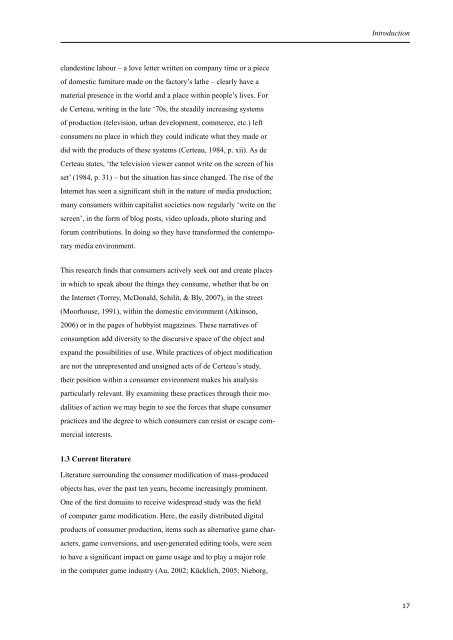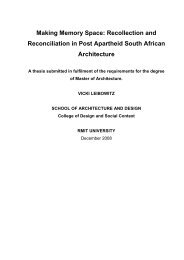Objects in Flux - RMIT Research Repository - RMIT University
Objects in Flux - RMIT Research Repository - RMIT University
Objects in Flux - RMIT Research Repository - RMIT University
Create successful ePaper yourself
Turn your PDF publications into a flip-book with our unique Google optimized e-Paper software.
clandest<strong>in</strong>e labour – a love letter written on company time or a piece<br />
of domestic furniture made on the factory’s lathe – clearly have a<br />
material presence <strong>in</strong> the world and a place with<strong>in</strong> people’s lives. For<br />
de Certeau, writ<strong>in</strong>g <strong>in</strong> the late ‘70s, the steadily <strong>in</strong>creas<strong>in</strong>g systems<br />
of production (television, urban development, commerce, etc.) left<br />
consumers no place <strong>in</strong> which they could <strong>in</strong>dicate what they made or<br />
did with the products of these systems (Certeau, 1984, p. xii). As de<br />
Certeau states, ‘the television viewer cannot write on the screen of his<br />
set’ (1984, p. 31) – but the situation has s<strong>in</strong>ce changed. The rise of the<br />
Internet has seen a significant shift <strong>in</strong> the nature of media production;<br />
many consumers with<strong>in</strong> capitalist societies now regularly ‘write on the<br />
screen’, <strong>in</strong> the form of blog posts, video uploads, photo shar<strong>in</strong>g and<br />
forum contributions. In do<strong>in</strong>g so they have transformed the contemporary<br />
media environment.<br />
This research f<strong>in</strong>ds that consumers actively seek out and create places<br />
<strong>in</strong> which to speak about the th<strong>in</strong>gs they consume, whether that be on<br />
the Internet (Torrey, McDonald, Schilit, & Bly, 2007), <strong>in</strong> the street<br />
(Moorhouse, 1991), with<strong>in</strong> the domestic environment (Atk<strong>in</strong>son,<br />
2006) or <strong>in</strong> the pages of hobbyist magaz<strong>in</strong>es. These narratives of<br />
consumption add diversity to the discursive space of the object and<br />
expand the possibilities of use. While practices of object modification<br />
are not the unrepresented and unsigned acts of de Certeau’s study,<br />
their position with<strong>in</strong> a consumer environment makes his analysis<br />
particularly relevant. By exam<strong>in</strong><strong>in</strong>g these practices through their modalities<br />
of action we may beg<strong>in</strong> to see the forces that shape consumer<br />
practices and the degree to which consumers can resist or escape commercial<br />
<strong>in</strong>terests.<br />
1.3 Current literature<br />
Literature surround<strong>in</strong>g the consumer modification of mass-produced<br />
objects has, over the past ten years, become <strong>in</strong>creas<strong>in</strong>gly prom<strong>in</strong>ent.<br />
One of the first doma<strong>in</strong>s to receive widespread study was the field<br />
of computer game modification. Here, the easily distributed digital<br />
products of consumer production, items such as alternative game characters,<br />
game conversions, and user-generated edit<strong>in</strong>g tools, were seen<br />
to have a significant impact on game usage and to play a major role<br />
<strong>in</strong> the computer game <strong>in</strong>dustry (Au, 2002; Kücklich, 2005; Nieborg,<br />
Introduction<br />
17
















